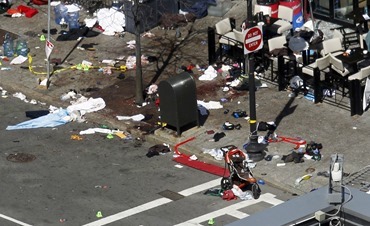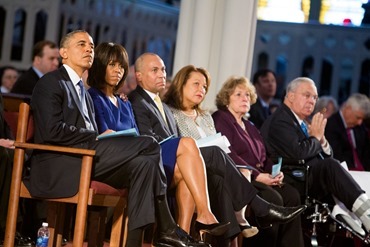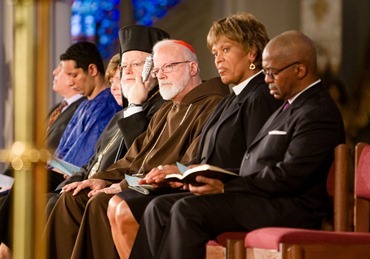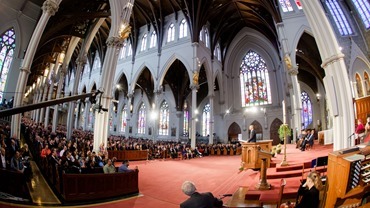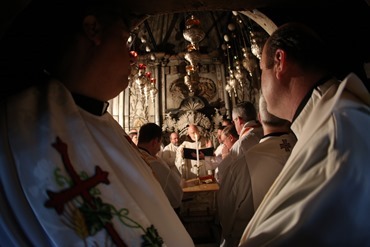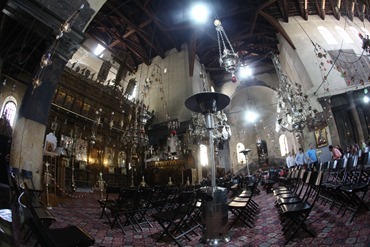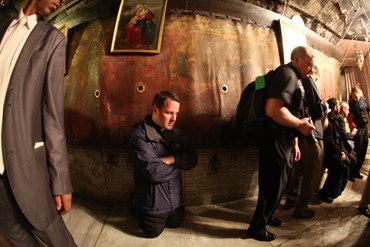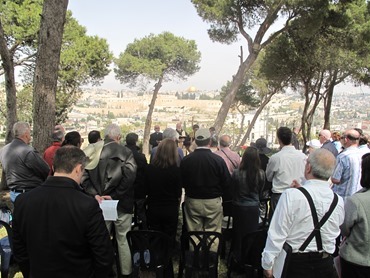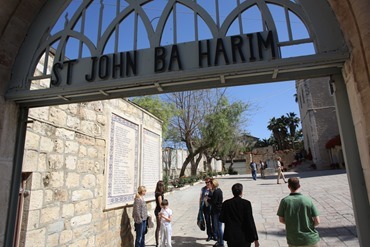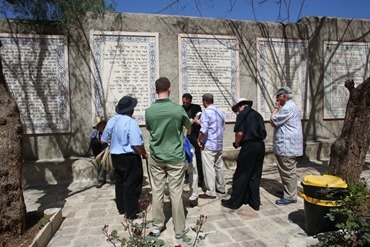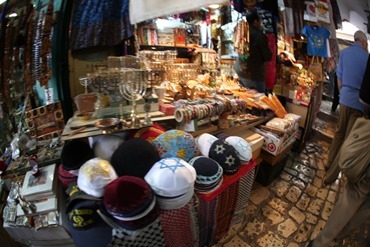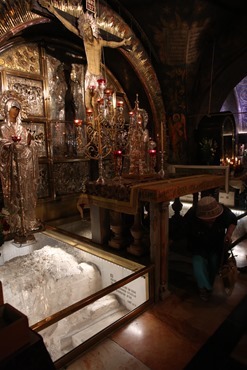On Monday, Patriots’ Day, we were on the last day of our retreat with the priests of the Archdiocese of Boston in the Holy Land. That evening, when I returned to the Notre Dame Center, which is a pilgrim hostel in Jerusalem right next to the Old City, I turned on the television to get the election results in Venezuela and, to my surprise, I saw Boston on the television as they were reporting on the bombings at the marathon’s finish line. I immediately called my office and was informed of what was happening here.
We issued a statement that same afternoon, expressing our deep sorrow, that I want to share with you:
The Archdiocese of Boston joins all people of good will in expressing deep sorrow following the senseless acts of violence perpetrated at the Boston Marathon today. Our prayers and concern are with so many who experienced the trauma of these acts, most especially the loved ones of those who lives were lost and those who were injured, and the injured themselves.
The citizens of the City of Boston and the Commonwealth of Massachusetts are blessed by the bravery and heroism of many, particularly the men and women of the police and fire departments and emergency services who responded within moments of these tragic events. Governor Patrick, Mayor Menino and Police Commissioner Davis are providing the leadership that will see us through this most difficult time and ensure that proper procedures are followed to protect the public safety.
In the midst of the darkness of this tragedy we turn to the light of Jesus Christ, the light that was evident in the lives of people who immediately turned to help those in need today. We stand in solidarity with our ecumenical and interfaith colleagues in the commitment to witness the greater power of good in our society and to work together for healing.
The next morning I spoke with the governor, who proposed the idea of an ecumenical service at the Cathedral of the Holy Cross. I told him we would be very pleased to host it.
My staff worked with his staff and the White House staff in preparing an interfaith service involving Catholics, Protestants, Jews, Muslims and Orthodox Christians, with the presence of the President.
Around 2,000 people came into the cathedral and many others remained outside.
There was long line of people outside the cathedral
waiting for the chance to enter
The whole region has been moved by this tragedy and people were anxious to be a part of this interreligious service. Of course CatholicTV broadcasted live the service and you can watch it in its entirety here:
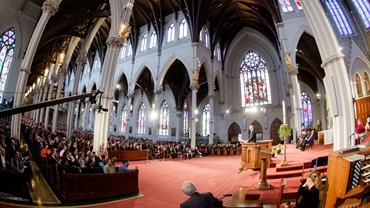
The Boston Children’s Choir was there participating as well as the Cathedral Choir.
Yo-yo Ma also contributed to the musical selection, and played a cello solo.
The former governors were there, Romney, Dukakis, Weld and Swift as well as some members of congress.
I think it was an important moment to show solidarity in our community and to commit ourselves to healing and to promoting a culture of life, by showing regard for every human being and having a sense of shared destiny in the need to promote the common good and to overcome the individualism and the ideological polarization that leads to this kind of violence in society.
Mayor Menino, who came in a wheelchair because he had fractured his leg near the ankle, stood as he addressed those attending the service.
In my talk, I expressed the message the Holy Father asked that I communicate to the people of Boston. I also reflected on the gospel reading from the Sermon on the Mount. I ended with the Prayer of St. Francis.
These were my remarks:
My dear brothers, sisters and friends.
On behalf of our Catholic community, I wish to welcome all of you here to the Cathedral of the Holy Cross. It is an honor to have our President, the Governor, and our Mayor here with us this morning. We are grateful to Governor Patrick for initiating this ecumenical and interfaith prayer service. We are delighted that Metropolitan Methodius and so many leaders from the various churches and faith communities could join us here today.
Our Holy Father, Pope Francis, has asked me to communicate to you his sentiments of love and support. The Holy Father invokes God’s peace upon our dead, consolation upon the suffering and God’s strength upon all those engaged in the continuing work of relief and response. The Holy Father prays that we will be united in the resolve not to be overcome by evil, but to combat evil with good, working together to build an ever more just, free and secure society for generations to come.
This year’s Patriots’ Day celebrations were marred by an act of senseless violence that has caused all of us great shock and pain. It made us relive the horror of the September 11th terrorist attack and is a stark reminder of the darkness that can lurk in the human heart and produce such evil. And yet the same tragedy brought us together as a community like nothing else ever could. The generous and courageous response of so many assures us that there resides in people’s hearts a goodness that is incredibly selfless. We saw that when summoned by great events we can be remarkably committed to the well-being of others, even total strangers. We become a stronger people, a more courageous people, and a more noble people. The police, emergency workers and even bystanders and passers-by did not hesitate to put themselves in harm’s way to help the injured and the frightened.
Our presence here is an act of solidarity with those who lost their lives or were injured in the explosions and an expression of our desire to support them and their families and loved ones.
This Patriots’ Day shakes us out of our complacency and indifference and calls us to focus on the task of building a civilization that is based on love, justice, truth and service. We do not want to risk losing the legacy of those first patriots who were willing to lay down their lives for the common good. We must overcome the culture of death by promoting a culture of life, a profound respect for each and every human being made in the image and likeness of God, and we must cultivate a desire to give our lives in the service of others.
Last week, I was in Galilee on the Mount of the Beatitudes with 30 priests from Boston. There we prayed together and listened to the very Gospel that was read for us here this morning. The Sermon on the Mount is a description of the life of the people gathered by and around the Lord. Often in the Gospels, we can see the contrast between the crowd and the community. The crowd is made up of self-absorbed individuals, each one focused on his or her own interests in competition with the conflicting projects of others. A community is where people come to value each other, and find their own identity in being part of something bigger than themselves, working together for the common good.
The Sermon on the Mount, in many ways, is the Constitution of the people called to live a new life. Jesus gives us a new way to deal with offenses, by reconciliation. Jesus gives us a new way to deal with violence, by nonviolence. He gives us a new way to deal with money, by sharing and providing for those in need. Jesus gives us a new way to deal with leadership, by drawing upon the gift of every person, each one a child of God.
In the face of the present tragedy, we must ask ourselves what kind of a community do we want to be, what are the ideals that we want to pass on to the next generation. It cannot be violence, hatred and fear. The Jewish people speak of Tikkun Olam, “repairing the world.” God has entrusted us with precisely that task, to repair our broken world. We cannot do it as a collection of individuals; we can only do it together, as a community, as a family. Like every tragedy, Monday’s events are a challenge and an opportunity for us to work together with a renewed spirit of determination and solidarity and with the firm conviction that love is stronger than death.
May ours be the sentiments of St. Francis of Assisi, who prayed:
Lord, make me an instrument of your peace,
Where there is hatred, let me sow love;
Where there is injury, pardon;
Where there is doubt, faith;
Where there is despair, hope;
Where there is sadness, joy.
O Divine Master,
grant that I may not so much seek to be consoled, as to console;
To be understood, as to understand;
To be loved, as to love.
For it is in giving that we receive.
It is in pardoning that we are pardoned,
and it is in dying that we are born to Eternal Life.
Amen.
CatholicTV has prepared a playlist of the service in YouTube so you can watch every moment here.
– – –
In last week’s post, I chronicled the first part of the retreat with priests in the Holy Land, that took place in northern Israel, around the Sea of Galilee.
Thursday evening we arrived in Jerusalem and stayed in the Notre Dame House, a retreat center entrusted to the Legionaries of Christ.
Our first stop on Friday was to visit the Latin Patriarchate. The patriarch, Fouad Twal, was in Rome to meet with the Holy Father so we met with one of his auxiliary bishops, Bishop William Shomali.
He spoke to us about the situation in the Holy Land and afterward bestowed the Pilgrim’s Shell on five of the priests who are members of the Order of the Holy Sepulchre, and were making their first trip to Jerusalem.
Then we spent the rest of the day visiting Holy Sites around Jerusalem, including the Mount of Olives and the Garden of Gethsemane, the Church of St. Peter Gallicantu, the Chapel of Dominus Flevit, and the Church of the Pater Noster.
There we ran into this group of Capuchins and a group of Polish pilgrims.
We had Mass at the Gallicantu, and visited the cistern there, where it is believed that Christ was held overnight during his trial. Father Bob Reed told me once that when he was a seminarian, he spent a night in that cistern!
Saturday, very early in the morning, we had Mass at the Holy Sepulchre. I was so moved by it. I did not realize that it was possible even to celebrate Mass there. When they told me the day before I was very excited.
The whole group of priests were able to go into the antechamber, and then we did the liturgy of the Word there and then went into the small room where the Holy Sepulchre is. On top of the Holy Sepulchre was actually the altar where we celebrated the Mass and it was a very moving experience.
I want to share with you the audio of my homily there:
From there we went to meet Father Pierbattista Pizzaballa, who is the Franciscan custodian of the Holy Land. He is the head of all Franciscans in the Holy Land.
Currently there are around 300 friars and around 100 sisters in the territory of the custody which includes Israel, the Palestinian Territories, Jordan, Syria, Lebanon, Egypt, and the islands of Cyprus and Rhodes.
He gave us a history of the presence of the friars there for 800 years, and the work that they do in the Holy Land.
He also talked about the importance of the Good Friday collection, which is taken up throughout the whole world, which began to be taken up in the 1400s. It is one of the oldest collections that we have. Two thirds of it is used for works of mercy, education and healthcare, and one third of that collection is used to support the holy places and the different shrines. It is a very important source of revenue for the Church in the Holy Land as it has been for several centuries.
After that, the priests went to Bethlehem, to visit the holy places there, including the manger, which is at the Basilica of the Nativity.
I, instead, spent some time with the lay people from Boston who had been with us in Galilee and were in Jerusalem at the same time we were.
We celebrated Morning Prayer at Domus Mamre, a beautiful location across from the walls of Jerusalem that belongs to the Syrian Catholic Church and is currently being used by the Neocatechumenal Way as a house of studies for seminarians and priests.
The venue is an extraordinary place that goes back to the time of Abraham. It is said of this place that Abraham, on his way to sacrifice his son Isaac, stopped there and told the servants to wait for them to get back from Mount Moria.
This is the site for the future Domus Jerusalem, a new retreat and conference center that will welcome pilgrims on their visit to Jerusalem.
Father Rino explained to the group that, like Domus Galilee, Domus Jerusalem will also serve as a center to promote interreligious dialogue, particularly with the Jewish world and we were able to show the group the plans that had been made.
It will be a wonderful site for the center and will also have accommodations for about 170 guests.
There is an ancient tomb from the first century on the property, and perhaps the most spectacular thing is the entire panorama of the temple and the Old City.
– – –
The next day, we went to Ein Karem where Mary’s cousin Elizabeth lived and the place of the visitation.
Outside the church, the Magnificat is written on all the walls in many different languages. We prayed and visited the church, then we went to another church nearby, St. John Ba-Harim, the site of the birth of John the Baptist.
At that church the Benedictus is also displayed in many different languages. I took a picture of the Latin version.
On the way back, we had a Holy Hour with the Blessed Sacrament at the garden of Gethsemane.
– – –
We had the Stations of the Cross on Monday and ended in the Holy Sepulchre.
Many of the stations are right through the streets of Jerusalem, surrounded by shops and the bustling of people and it gives the impression that that is what it would have been like at the time of Jesus.
Monday afternoon we went to hear the Dominican Friar Jerome Murphy O’Connor who is a famous scripture scholar. We went to the Ecole Biblique de Jerusalem, and he gave us a very interesting lecture.
The next day, I went to visit my brother Capuchins in the Holy Land, to the house they have in the new city, in the Talbiye neighborhood. The house was built in 1933 because at the time there was a Christian population in the area. It is currently in a Jewish neighborhood. The house was abandoned during the second world war, but it was given back in the 1990s. In 2010 the new center was inaugurated. The theme of the house is “Christ, the light of the world.”
While I was there I took some photos.
A picture of the altar
Mary, “a woman clothed with the sun,”
as described in the Book of Revelation
This is the tabernacle. It looks like a burning bush under the meeting tent
That is the first word of the Shema on the pulpit, “listen”
This is Father Benoit a Capuchin who is a righteous gentile and saved 4,000 Jews from the Nazis
This is Blessed James Haddad, the Capuchin who started the house. He has just been beatified
As we publish this post, law enforcement officials are trying to apprehend an individual in relation with the Marathon bombings. One police officer was killed yesterday evening and another is in critical condition. Our prayers are with the victims and their families as well as with those who are risking their lives to keep our community safe.
Until my next post,
Cardinal Seán


